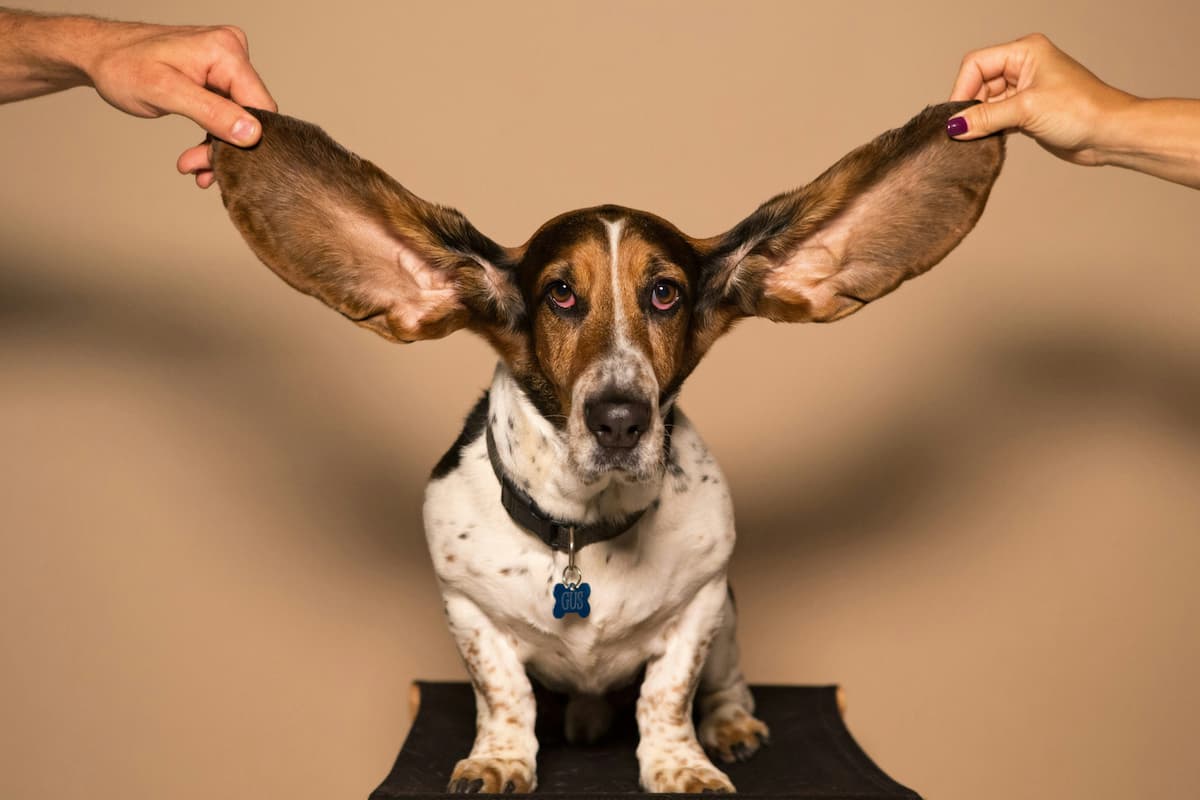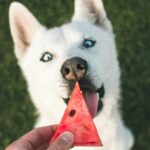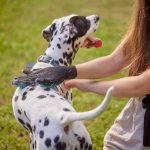Picture this: a sunny, grassy park teeming with vibrant colors and alive with boisterous barks and wagging tails.
As you stroll through this wonderland of wagging wonders, an enchanting sight catches your eye.
It’s a playful pup scurrying about, delightfully nipping at its fellow canine companion’s ears.
You can’t help but wonder: Why on Earth do dogs find so much joy in this peculiar ear-nibbling ritual?
Read on to learn more about the ear-biting facts behind this habit.
Why Do Dogs Bite Each Other’s Ears When Playing?
Dogs are social creatures who love to play and interact with each other.
While playing, you may notice that dogs often bite each other’s ears.
But have you ever wondered why they do this?
Let’s delve deeper into this quirky behavior and uncover the reasons behind it.
Dogs biting each other’s ears more seem like a curious sight but there are several scientific reasons behind this behavior:
1. Communication through Body Language
Dogs communicate through a combination of barks, growls, and body language cues.
When dogs play, one way they communicate with each other is through gentle biting of the ears.
This behavior is a form of social interaction and helps dogs establish trust and understanding.
By nipping at each other’s ears, dogs convey their intentions and set boundaries while engaging in play.
2. Exploring Their Canine Instincts
Another reason dogs bite each other’s ears during playtime is rooted in their primal instincts.
Similar to their wild ancestors, domestic dogs have a natural drive to explore and display certain behaviors.
Playful ear-biting mimics the behaviors of hunting or defending territory.
This harmless biting allows dogs to fulfill their natural instincts while interacting with their fellow canine friends.
3. Establishing Dominance
Canines are pack animals, and within a pack, there’s always a hierarchy.
When dogs bite each other’s ears during play, it can be a way to assert dominance.
By targeting the ears, a sensitive and vulnerable area, dogs can communicate their status and establish who’s in charge.
It’s their way of showing who’s the “top dog” without causing any serious harm.
4. Bonding and Building Relationships
Ear-biting during play can also contribute to strengthening the bond between dogs.
Much like humans hugging or shaking hands, dogs use physical contact to foster connections.
By gently biting each other’s ears, dogs engage in a form of social grooming, creating a sense of companionship and trust.
This behavior helps strengthen their relationships, making playtime all the more enjoyable for our furry friends.
5. Exploring the World
For dogs, exploring the world often involves sniffing, licking, and tasting objects around them.
When two dogs play and one starts nibbling on the other’s ears, it could simply be a way of satisfying their innate curiosity.
Ears are rich in scents and textures, making them an enticing object for investigation.
So, while it may appear like a playful nibble, it’s actually their way of acquainting themselves with the world around them.
Differentiating Between Harmless Ear Biting and Aggressive Behavior
Now that you know why dogs bite each other’s ears, it is important that you understand the differences between harmless ear biting and aggressive behavior in order to ensure the safety and well-being of our furry companions.
When dogs engage in playful ear biting, it is usually a way for them to communicate and establish their social hierarchy.
It’s important to remember that dogs rely heavily on body language and non-verbal cues to express themselves.
By biting each other’s ears, dogs are mimicking natural behaviors seen in their wild counterparts.
It’s their way of playfully asserting dominance or simply letting off some steam.
So, if you see two dogs energetically engaged in ear biting while maintaining a relaxed and loose body posture, chances are it’s all in good fun.
On the other hand, aggressive ear biting is a whole different ball game.
If you observe any signs of tension, such as stiff body language, raised hackles, growling, or snarling, this may indicate that the dogs have crossed the line into aggression.
Aggressive ear biting is often accompanied by other aggressive behaviors, like lunging, snapping, or even biting with intent to harm.
This type of behavior can be a result of fear, territoriality, or resource guarding.
If you witness any signs of aggression during ear biting, it’s crucial to intervene and separate the dogs to prevent any potential harm.
In conclusion, while ear biting between dogs during play can be a harmless and natural behavior, it’s essential to know the difference between playfulness and aggression.
Understanding the dogs’ body language, their overall behavior, and the presence or absence of accompanying aggressive signals will help you differentiate between the two.
By paying close attention and ensuring a safe environment for all dogs, you can foster a positive play experience and maintain healthy social interactions at the dog park.
Tips for Preventing Excessive Ear Biting during Playtime
Now that you know the signs, you must remember that excessive or aggressive ear biting should be monitored and discouraged.
If you notice that your dog is repeatedly biting ears too forcefully, it might be a sign that their playtime is getting out of hand.
To prevent excessive ear biting during play, here are a few tips:
1. Socialization: Make sure your dog is properly socialized from a young age, as this can help them develop appropriate play behaviors and understand boundaries.
2. Training: Teach your dog basic obedience commands, such as “leave it” or “gentle,” which can help redirect their behavior and discourage excessive ear biting.
3. Supervision: Always keep a close eye on your dog during playtime and intervene if things start to escalate.
If you notice any signs of discomfort or aggression, separate the dogs and give them a break to cool down.
In summary, when dogs bite each other’s ears during play, it can serve as a means of communication and an expression of their natural instincts.
As long as the behavior is mutual and both dogs are enjoying themselves, it is generally a harmless and normal part of canine play.
However, as with any interaction between dogs, it’s essential to prioritize their safety and well-being by being attentive and stepping in if necessary.
So, the next time you witness this intriguing behavior at the dog park, you’ll have a better understanding of why dogs engage in ear-biting play.
FAQ
Q: So, why do dogs seem to have a particular interest in biting each other’s ears?
A: Well, it turns out that ear-biting during play is rather common among dogs.
This behavior is actually an instinctual carryover from their wild ancestors, who used to bite each other’s ears as a form of communication during hunting or social interactions.
Q: Ah, it’s interesting to know that this behavior has evolutionary roots.
But, what message are they conveying to each other through ear-biting?
A: Great question!
When dogs playfully nip at each other’s ears, they are usually sending signals to communicate different things.
Firstly, it’s often a sign of trust and affection for one another. By gently biting their playmate’s ears, dogs are expressing their bond and social connection.
Q: That’s heartwarming to hear!
Is there any other purpose to ear-biting during play?
A: Indeed, there is!
Ear-biting can serve as a way to initiate or maintain the play’s momentum.
It’s like their way of saying, ”Hey, let’s keep going, this is fun!” It adds an extra element of excitement and engagement to the play session.
Q: Sometimes, though, it seems like dogs take it a bit too far and the play can become rough.
Is ear-biting then a sign of aggression?
A: It might appear alarming when things start to get intense during play, but most often, ear-biting is not an aggressive move.
However, there may be instances where dogs cross the line, and the play escalates into aggression.
It’s important for pet owners to observe their dogs closely and intervene if the play starts turning aggressive.
Q: Should humans get involved and discourage when dogs start to ear-biting during play?
A: Generally, it is best to let dogs engage in appropriate play behaviors unless it becomes aggressive.
Dogs need outlets for their natural instinct to interact and play, and ear-biting can be a harmless part of that.
However, if it seems excessive or becomes a discomfort for one of the dogs involved, gently redirecting their attention to other play behaviors may be a good idea.
Closing the Chapter
While it may seem strange to us humans, dogs have their own unique language when it comes to communication, and ear-biting is just another way for them to express themselves.
It’s their equivalent of a playful handshake or a friendly pat on the back.
Through ear-biting, our canine pals establish and maintain bonds with their furry friends.
It’s a way for them to engage in social interactions, build trust, and strengthen their relationships.
Just like humans, dogs have their own social norms and etiquettes, and ear-biting is simply a part of their playful doggy etiquette.
It’s important to remember that ear-biting during play is usually done in a gentle manner.
Dogs have a natural sense of fairness and know how to gauge their playmate’s comfort level.
They might nibble or lightly tug on each other’s ears, but rarely do they cause any harm.
Of course, there are always exceptions to every rule.
Some dogs may exhibit more intense ear-biting behavior, especially if they are overly excited or have a certain personality.
In such cases, it’s crucial for us as responsible pet owners to monitor the situation closely and step in if things get out of hand.
Ensuring that play remains safe and enjoyable for all parties involved is key.
So next time you witness two furry friends engaged in a boisterous play session, don’t be surprised if you catch them nibbling on each other’s ears.
It’s their unique way of showing affection, strengthening bonds, and having a jolly good time.
Remember, dogs are like us in many ways – they have their own language and customs.
And when they communicate through innocent acts like ear-biting, it’s a reminder of how wonderfully diverse and fascinating the animal kingdom can be.














